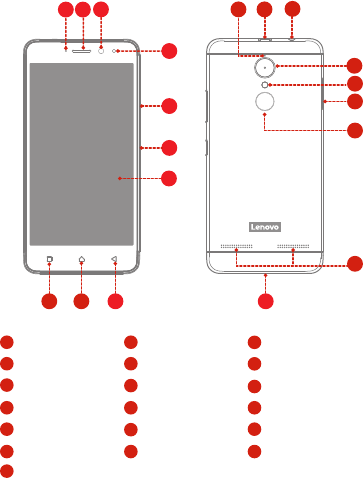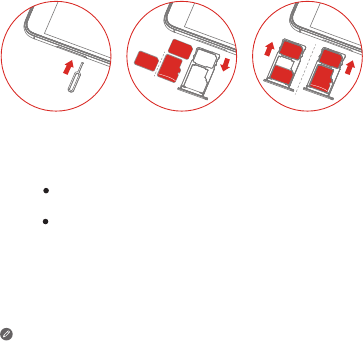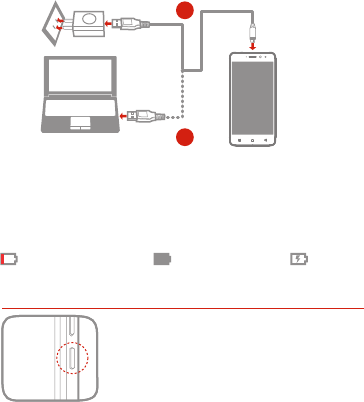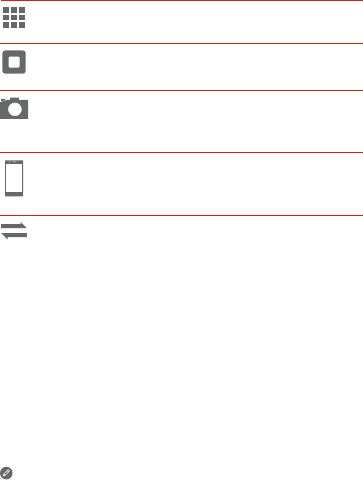Lenovo Mobile Communication Technology K33B36 Mobile Cellular Phone User Manual
Lenovo Mobile Communication Technology Ltd. Mobile Cellular Phone
User manual

Quick Start Guide
Read this guide carefully before using your smartphone.
Lenovo K6
Lenovo K33b36

Reading before using your smartphone
For your safety
Before assembling, charging or using your mobile device for the first
time, please read the important product safety and legal information
provided with your product. If your mobile device becomes
unresponsive, try a reboot—press and hold the On/Off button until the
screen goes dark and your device restarts.
Usage
This phone supports apps and services that may use a lot of data, so
make sure your data plan meets your needs. Contact your service
provider for details. Certain apps and features may not be available in
all countries.
Electrical requirements
Battery: 3.85 Vcc 3000 mAh 11.6 Wh
Adapter: AC
Entrance: 100 - 240 Vca 50/60 Hz 0.3/0.5 A
Exit: 5.2 Vcc 2.0 A

First glance
Front-facing camera
3
1Receiver
2
On/Off button
6
Light/Proximity sensor
Indicator
4Volume buttons
5
Home button
9
Touch screen
7Back button
8
Flash
Touch ID
12
Multitask button
10
Rear-facing camera
11
Headset connector
Speaker
16
1513
Card tray
14
Micro USB connector
17 18
Microphone
19
Anti-noise microphone
1211
2
4
1
14
13
15
16
18
17
6
8199
5
7
3
10

Installing the Nano-SIM & microSD cards
A Nano-SIM card provided by your carrier is required in order to use
cellular services
①
. A microSD card is required to store data.
Install the Nano-SIM cards and the microSD card as shown
②
.
①Only Nano-SIM cards work with your smartphone.
②Always turn off your smartphone first before you insert or remove a
Nano-SIM card. Insert or remove a Nano-SIM card with your
smartphone on may damage your Nano-SIM card or smartphone
permanently.
③Both of the card slots support 4G/3G/2G data services, but you can
enable only one Nano-SIM card for data connection at a time. If you
want to change the Nano-SIM card used for data connection, go to
Settings > SIM management.
Step 1.
Step 2.
Step 3.
Insert the eject tool that comes with your smartphone into
the hole in the card tray.
Pull out the card tray and do one of the following:
Position a Nano-SIM card in Slot 1 and a microSD card
in Slot 2;
Position a Nano-SIM card in Slot 1 and another
Nano-SIM card in Slot 2
③
.
Carefully insert the tray with the installed cards back into the
slot.
SIM
SIM
microSD
Slot1
Slot2
SIM
SIM
SIM
microSD

Low battery power Fully charged Charging
Charge the battery as shown.
Turning on or turning off your smartphone
Turn on: Press and hold the On/Off button until
the Lenovo logo appears.
Turn of f: Press and hold the On/Off button for a
few seconds, then tap Power off.
Restart: Press and hold the On/Off button for a
few seconds, then tap Restart.
Method 1.
Method 2.
Connect your smartphone to a power outlet using the
cable and USB power adapter that come with your
smartphone.
Connect your smartphone to a computer using the cable
that comes with your smartphone.
Charging the battery
2
1
FCC Regulations:
This mobile phone complies with part 15 of the FCC Rules. Operation
is subject to the following two conditions: (1) This device may not
cause harmful interference, and (2) this device must accept any
interference received, including interference that may cause undesired
operation.
This mobile phone has been tested and found to comply with the
limits for a Class B digital device, pursuant to Part 15 of the FCC
Rules. These limits are designed to provide reasonable protection
against harmful interference in a residential installation. This equipment
generates, uses and can radiated radio frequency energy and, if not
installed and used in accordance with the instructions, may cause
harmful interference to radio communications. However, there is no
guarantee that interference will not occur in a particular installation If
this equipment does cause harmful interference to radio or television
reception, which can be determined by turning the equipment off and
on, the user is encouraged to try to correct the interference by one or
more of the following measures:
-Reorient or relocate the receiving antenna.
-Increase the separation between the equipment and receiver.
-Connect the equipment into an outlet on a circuit different from that
to which the receiver is connected.
-Consult the dealer or an experienced radio/TV technician for help.
FCC Note:
Caution: Changes or modifications not expressly approved by the
party responsible for compliance could void the user‘s authority to
operate the equipment.
RF Exposure Information (SAR)
This phone is designed and manufactured not to exceed the emission
limits for exposure to radio frequency (RF) energy set by the Federal
Communications Commission of the United States.
During SAR testing, this device was set to transmit at its highest
certified power level in all tested frequency bands, and placed in
positions that simulate RF exposure in usage against the head with
no separation, and near the body with the separation of 15 mm.
Although the SAR is determined at the highest certified power level,
the actual SAR level of the device while operating can be well below
the maximum value. This is because the phone is designed to
operate at multiple power levels so as to use only the power required
to reach the network. In general, the closer you are to a wireless
base station antenna, the lower the power output.
The exposure standard for wireless devices employing a unit of
measurement is known as the Specific Absorption Rate, or SAR.
The SAR limit set by the FCC is 1.6W/kg.
This device is complied with SAR for general population /uncontrolled
exposure limits in ANSI/IEEE C95.1-1992 and had been tested in
accordance with the measurement methods and procedures
specified in IEEE1528.
The FCC has granted an Equipment Authorization for this model
phone with all reported SAR levels evaluated as in compliance with
the FCC RF exposure guidelines. SAR information on this model
phone is on file with the FCC and can be found under the Display
Grant section of www.fcc.gov/oet/ea/fccid after searching on FCC ID:
YCNK33B36.
For this device, the highest reported SAR value for usage against the
head is 0.53 W/kg, for usage near the body is 0.74 W/kg.
While there may be differences between the SAR levels of various
phones and at various positions, they all meet the government
requirements.
SAR compliance for body-worn operation is based on a separation
distance of 15 mm between the unit and the human body. Carry this
device at least 15 mm away from your body to ensure RF exposure
level compliant or lower to the reported level. To support body-worn
operation, choose the belt clips or holsters, which do not contain
metallic components, to maintain a separation of 15 mm between this
device and your body.
RF exposure compliance with any body-worn accessory, which
contains metal, was not tested and certified, and use such body-worn
accessory should be avoided.
Additional information can be found at www.lenovo.com.
FCC Regulations:
This mobile phone complies with part 15 of the FCC Rules. Operation
is subject to the following two conditions: (1) This device may not
cause harmful interference, and (2) this device must accept any
interference received, including interference that may cause undesired
operation.
This mobile phone has been tested and found to comply with the
limits for a Class B digital device, pursuant to Part 15 of the FCC
Rules. These limits are designed to provide reasonable protection
against harmful interference in a residential installation. This equipment
generates, uses and can radiated radio frequency energy and, if not
installed and used in accordance with the instructions, may cause
harmful interference to radio communications. However, there is no
guarantee that interference will not occur in a particular installation If
this equipment does cause harmful interference to radio or television
reception, which can be determined by turning the equipment off and
on, the user is encouraged to try to correct the interference by one or
more of the following measures:
-Reorient or relocate the receiving antenna.
-Increase the separation between the equipment and receiver.
-Connect the equipment into an outlet on a circuit different from that
to which the receiver is connected.
-Consult the dealer or an experienced radio/TV technician for help.
FCC Note:
Caution: Changes or modifications not expressly approved by the
party responsible for compliance could void the user‘s authority to
operate the equipment.
RF Exposure Information (SAR)
This phone is designed and manufactured not to exceed the emission
limits for exposure to radio frequency (RF) energy set by the Federal
Communications Commission of the United States.
During SAR testing, this device was set to transmit at its highest
certified power level in all tested frequency bands, and placed in
positions that simulate RF exposure in usage against the head with
no separation, and near the body with the separation of 10 mm.
Although the SAR is determined at the highest certified power level,
the actual SAR level of the device while operating can be well below
the maximum value. This is because the phone is designed to
operate at multiple power levels so as to use only the power required
to reach the network. In general, the closer you are to a wireless
base station antenna, the lower the power output.
The exposure standard for wireless devices employing a unit of
measurement is known as the Specific Absorption Rate, or SAR.
The SAR limit set by the FCC is 1.6W/kg.
This device is complied with SAR for general population /uncontrolled
exposure limits in ANSI/IEEE C95.1-1992 and had been tested in
accordance with the measurement methods and procedures
specified in IEEE1528.
The FCC has granted an Equipment Authorization for this model
phone with all reported SAR levels evaluated as in compliance with
the FCC RF exposure guidelines. SAR information on this model
phone is on file with the FCC and can be found under the Display
Grant section of www.fcc.gov/oet/ea/fccid after searching on FCC ID:
YCNK33B36.
For this device, the highest reported SAR value for usage against
the head is 0.53 W/kg, for usage near the body is 1.44 W/kg.
While there may be differences between the SAR levels of various
phones and at various positions, they all meet the government
requirements.
SAR compliance for body-worn operation is based on a separation
distance of 15 mm between the unit and the human body. Carry this
device at least 15 mm away from your body to ensure RF exposure
level compliant or lower to the reported level. To support body-worn
operation, choose the belt clips or holsters, which do not contain
metallic components, to maintain a separation of 15 mm between this
device and your body.
RF exposure compliance with any body-worn accessory, which
contains metal, was not tested and certified, and use such body-worn
accessory should be avoided.
Additional information can be found at www.lenovo.com.
FCC Regulations:
This mobile phone complies with part 15 of the FCC Rules. Operation
is subject to the following two conditions: (1) This device may not
cause harmful interference, and (2) this device must accept any
interference received, including interference that may cause undesired
operation.
This mobile phone has been tested and found to comply with the
limits for a Class B digital device, pursuant to Part 15 of the FCC
Rules. These limits are designed to provide reasonable protection
against harmful interference in a residential installation. This equipment
generates, uses and can radiated radio frequency energy and, if not
installed and used in accordance with the instructions, may cause
harmful interference to radio communications. However, there is no
guarantee that interference will not occur in a particular installation If
this equipment does cause harmful interference to radio or television
reception, which can be determined by turning the equipment off and
on, the user is encouraged to try to correct the interference by one or
more of the following measures:
-Reorient or relocate the receiving antenna.
-Increase the separation between the equipment and receiver.
-Connect the equipment into an outlet on a circuit different from that
to which the receiver is connected.
-Consult the dealer or an experienced radio/TV technician for help.
FCC Note:
Caution: Changes or modifications not expressly approved by the
party responsible for compliance could void the user‘s authority to
operate the equipment.
RF Exposure Information (SAR)
This phone is designed and manufactured not to exceed the emission
limits for exposure to radio frequency (RF) energy set by the Federal
Communications Commission of the United States.
During SAR testing, this device was set to transmit at its highest
certified power level in all tested frequency bands, and placed in
positions that simulate RF exposure in usage against the head with
no separation, and near the body with the separation of 15 mm.
Although the SAR is determined at the highest certified power level,
the actual SAR level of the device while operating can be well below
the maximum value. This is because the phone is designed to
operate at multiple power levels so as to use only the power required
to reach the network. In general, the closer you are to a wireless
base station antenna, the lower the power output.
The exposure standard for wireless devices employing a unit of
measurement is known as the Specific Absorption Rate, or SAR.
The SAR limit set by the FCC is 1.6W/kg.
This device is complied with SAR for general population /uncontrolled
exposure limits in ANSI/IEEE C95.1-1992 and had been tested in
accordance with the measurement methods and procedures
specified in IEEE1528.
The FCC has granted an Equipment Authorization for this model
phone with all reported SAR levels evaluated as in compliance with
the FCC RF exposure guidelines. SAR information on this model
phone is on file with the FCC and can be found under the Display
Grant section of www.fcc.gov/oet/ea/fccid after searching on FCC ID:
YCNK33B36.
For this device, the highest reported SAR value for usage against the
head is 0.53 W/kg, for usage near the body is 0.74 W/kg.
While there may be differences between the SAR levels of various
phones and at various positions, they all meet the government
requirements.
SAR compliance for body-worn operation is based on a separation
distance of 10 mm between the unit and the human body. Carry this
device at least 10 mm away from your body to ensure RF exposure
level compliant or lower to the reported level. To support body-worn
operation, choose the belt clips or holsters, which do not contain
metallic components, to maintain a separation of 10 mm between this
device and your body.
RF exposure compliance with any body-worn accessory, which
contains metal, was not tested and certified, and use such body-worn
accessory should be avoided.
Additional information can be found at www.lenovo.com.
Copyright and trademarks
Certain features, services and applications are network dependent
and may not be available in all areas; additional terms, conditions
and/or charges may apply. Contact your service provider for details.
All features, functionality, and other product specifications, as well as
the information contained in this guide, are based upon the latest
available information and believed to be accurate at the time of
printing. Lenovo reserves the right to change or modify any
information or specifications without notice or obligation.
Note: The images in this guide are examples only.
Lenovo and the Lenovo logo are trademarks of Lenovo in the United
States, other countries, or both.
Manufactured under license from Dolby Laboratories. Dolby, Dolby
Atmos, and the double-D symbol are trademarks of Dolby
Laboratories.
Android, Google and other trademarks are owned by Google Inc. The
Android robot is reproduced or modified from work created and
shared by Google and used according to terms described in the
Creative Commons 3.0 Attribution License. All other product or
service names are the property of their respective owners.
© Copyright Lenovo 2016.
Product ID: Lenovo K6 (Model Lenovo K33b36)

① In some countries, LTE is not supported. To know if your
smartphone works with LTE networks in your country, contact
your carrier.
System: Android
System
Technical specifications
Rear: 13 megapixels
Front: 8 megapixels
Processor: Qualcomm MSM 8937, octa-core
Processor
Camera
Size: 12.7 cm (5.0 inches)
Resolution: 1080 × 1920 pixels
Bluetooth: Bluetooth 4.2;
WLAN: WLAN 802.11 b/g/n, 2.4 GHz;
Data: ①FDD-LTE/WCDMA/GSM;
GPS: Supported
GLONASS: Supported
Display
Wireless communication
Screen: multi-touch
LCD type: IPS

This product meets the applicable national or
international RF exposure guidance (SAR guideline)
when used normally against your head or, when worn
or carried, at a distance of 10 mm from the body. The SAR
guideline includes a considerable safety margin designed to
assure the safety of all persons, regardless of age and health.
XXXXXXXXXX
Printed in China
V1.0_20160901
Learning more
Getting support
To get support on network service and billing, contact your wireless
network operator. To learn how to use your smartphone and view its
technical specifications, go to http://support.lenovo.com.
Downloading publications
To obtain the latest smartphone manuals, go to:
http://support.lenovo.com
Accessing your User Guide
Your User Guide contains detailed information about your
smartphone. To access your User Guide, go to http://support.leno-
vo.com and follow the instructions on the screen.